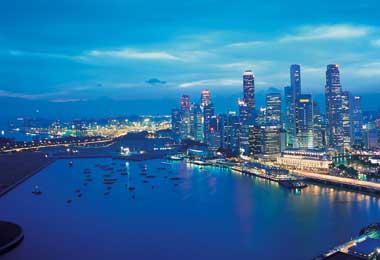Off Duty: Singapore
The Lion City is re-inventing itself again to stay ahead of the Asia pack. Matthew Brace hits the town

Your support helps us to tell the story
From reproductive rights to climate change to Big Tech, The Independent is on the ground when the story is developing. Whether it's investigating the financials of Elon Musk's pro-Trump PAC or producing our latest documentary, 'The A Word', which shines a light on the American women fighting for reproductive rights, we know how important it is to parse out the facts from the messaging.
At such a critical moment in US history, we need reporters on the ground. Your donation allows us to keep sending journalists to speak to both sides of the story.
The Independent is trusted by Americans across the entire political spectrum. And unlike many other quality news outlets, we choose not to lock Americans out of our reporting and analysis with paywalls. We believe quality journalism should be available to everyone, paid for by those who can afford it.
Your support makes all the difference.Why?
Visitors to Singapore can savour local Peranakan dumplings for breakfast, speed-shop for cut-price designer wear along Orchard Road, dine big on fish-head curry for lunch, visit a mosque, a Sikh temple and a Chinatown museum in the afternoon, and pick up a year's worth of fine woollen socks for a song.
And that's all before supper, which could be in a roof-top Italian restaurant, a flash-frying tom-yum soup emporium or a traditional Chinese restaurant complete with deep-fried scorpions.
No other Asian city offers as much variety. Its different ethnicities have kept their identities and their uniquely coloured and flavoured neighbourhoods: Little India, Chinatown, the Arab quarter, the Malaysian-influenced hawker food markets, the British colonial monoliths on the fringes of the CBD, and the beautifully restored temples along Telok Ayer Street.
These are not cosmetic, gimmicky ghettoes. They have grown and morphed with it, and now, as the city undergoes its biggest urban transformation in decades – on land reclaimed from the sea around Marina Bay - Singapore is reinventing itself again.
What?
The best history lesson can be found at the superb Chinatown Heritage Centre (48 Pagoda Street, www.chinatownheritage.com.sg), which traces the lives of early Chinese settlers. The street is also a good example of traditional shop-house architecture, terraces of buildings where original Singaporeans worked and traded at street level, and retired upstairs to live and sleep.
Another must is the cluster of temples down Telok Ayer Street. This was the original city waterfront where the first Chinese merchants landed after their long ocean voyages. To give thanks for safe passage over the South China Sea they immediately built shrines. The most fascinating is the recently restored Taoist Thian Hock Keng temple, where you can pay homage to a dozen different deities.
If you want guided tours then the Singapore Tourism Board has specialist ones to suit just about everyone. There are nature rambles, brewery tours, golf tours... even visiting architects and town planners are catered for with a special urban planning tour.
If time is tight and you are squeezing in some culture between meetings then you might want to hire one of the city's ever-courteous and knowledgeable taxi tourist guides (contact Singapore Tourism Board, www.visitsingapore.com). Pick your own route, or ask your driver to suggest an itinerary.
Get them to drop you at Mustafa Centre in Little India (Syed Alwi Road, www.mustafa.com.sg) in Little India. Singapore regulars flock here to stock up on good-quality underwear and socks at knock-down prices. It might feel like the London sales on Boxing Day but it's worth it.
Where?
If you want to push the boat out for supper then book ahead for San Marco, an Italian restaurant housed in an old lighthouse on the roof of the triumphantly columned Fullerton Hotel (1 Fullerton Square near Raffles Place, www.fullertonhotel.com). It's serene, quiet and serves such delights as Foie Gras pan-fried with coffee oil, and roasted rack of piglet.
For the best South Indian fish-head curry outside Kerala try the Banana Leaf Apolo café (54-58 Race Course Road; www.bananaleafapolo.com) on the edge of Little India.
Still one of the most appealing watering holes in town is New Asia Bar on level 71/72 of the Swissôtel The Stamford hotel ( www.swissotel.com/singapore-stamford) from where the views are unparalleled. A floor below is an excellent cigar club called City Space Bar, which serves mouth-watering Iranian caviar to high-flying bankers.
The newest and hippest place in town is St James Power Station ( www.stjamespowerstation.com), Singapore's fresh nightclub hub. Housed in the city's first coal-fired power station are nine different clubs, which are a huge hit the locals, for whom dancing with abandon is something of art-form. You can start at Movida for Latin jazz, move on to Powerhouse for house music, then chill out to American jazz classics in the Bellini Room.
Wow
The Fullerton Hotel, is still the most striking building in Singapore. Back in 1928 when it opened as the GPO, it was the epitome of colonial confidence and a sure sign that this city was going places. It has lost none of its grandeur, and now houses one of the best hotels in Asia.
An imminent 'wow' is the Singapore Flyer (Marina Bay, www.singaporeflyer.com.sg) a gigantic wheel 35m taller than the London Eye, which will open to the public in spring 2008.
Join our commenting forum
Join thought-provoking conversations, follow other Independent readers and see their replies
Comments